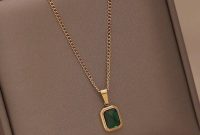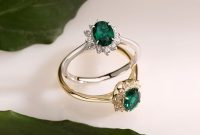The History of Emerald: From Ancient Egypt to Modern Fashion
 Emerald, with its lush green allure, has captivated humanity for millennia. Known as the “jewel of kings” and the “stone of Venus,” it has been prized not only for its beauty but also for its mysticism, symbolism, and status. From the sands of Ancient Egypt to the runways of modern fashion capitals, emerald has maintained its position as one of the world’s most treasured gemstones. This article takes a journey through time to explore how emerald evolved in history—its spiritual importance, cultural roles, and continued relevance in today’s fashion industry.
Emerald, with its lush green allure, has captivated humanity for millennia. Known as the “jewel of kings” and the “stone of Venus,” it has been prized not only for its beauty but also for its mysticism, symbolism, and status. From the sands of Ancient Egypt to the runways of modern fashion capitals, emerald has maintained its position as one of the world’s most treasured gemstones. This article takes a journey through time to explore how emerald evolved in history—its spiritual importance, cultural roles, and continued relevance in today’s fashion industry.
Emerald in Ancient Egypt Few cultures embraced emerald as passionately as the Ancient Egyptians. Dating back to at least 330 BC, emeralds were mined in Egypt in a region later named Cleopatra’s Mines, after the legendary queen who adored the stone. Cleopatra’s affinity for emerald was so great that she claimed exclusive rights to Egypt’s mines during her reign.
To the Egyptians, emerald symbolized fertility, rebirth, and eternal youth. It was associated with the goddess Isis, who represented life and healing. Emerald amulets and jewelry were commonly placed in tombs to offer protection and eternal vitality to the deceased. These green stones were also believed to grant foresight and were used by priests and royalty during sacred ceremonies.
Cleopatra herself was known to gift emeralds engraved with her likeness to visiting dignitaries, leveraging the gem not only for its beauty but for its political and diplomatic power.
The Roman and Greek Perspectives The ancient Greeks and Romans also held emerald in high esteem. To the Greeks, emerald symbolized love and beauty and was sacred to the goddess Aphrodite. The Roman philosopher and naturalist Pliny the Elder famously wrote about emeralds in his encyclopedic Natural History, claiming that “nothing greens greener” and that the stone had a soothing effect on the eyes—a belief still held in some circles today.
Roman emperors and elites adorned themselves with emeralds as a symbol of wealth and power. Nero, it is said, watched gladiator games through an emerald, possibly to protect his eyes from the sun’s glare or simply to appreciate the spectacle in verdant tint. The stone was also believed to bring wisdom and protect against evil spells, making it a staple in both ornamentation and spiritual practice.
The Middle Ages and Mysticism During the Middle Ages, emeralds took on new symbolic meanings, particularly within Christian Europe. They were considered a stone of insight, believed to enhance memory and reveal truths. Clergy and scholars often wore emeralds to symbolize divine revelation and spiritual clarity. Legends of the Holy Grail sometimes included emeralds, with some stories claiming the cup was carved from a giant emerald.
The mystical aspect of emerald also grew during this period. Alchemists and healers believed the stone could cure diseases, especially those related to the eyes and heart. Worn over the heart, emerald was said to guard against unfaithfulness and improve eloquence. It was often set in religious artifacts and royal regalia, believed to connect the wearer to divine wisdom and heavenly protection.
Meanwhile, in Islamic culture, emeralds were considered highly spiritual and were engraved with verses from the Qur’an. They became popular among nobility in the Middle East, where emerald was revered for its connection to paradise and the Prophet Muhammad.
The Age of Exploration and the Columbian Emerald Boom The Age of Exploration in the 15th and 16th centuries marked a pivotal point in the history of emerald. Spanish conquistadors, in their conquest of the New World, encountered the rich emerald mines of Colombia—particularly in the Muzo and Chivor regions. The indigenous Muzo people had been mining and treasuring emeralds for centuries before the arrival of Europeans.
The Spanish were astounded by the size, clarity, and color of Colombian emeralds, which far surpassed any they had seen before. Emeralds from the New World quickly became coveted throughout Europe and Asia, often exchanged for gold, silver, and silk. They found their way into the treasuries of European monarchs, Indian maharajas, Persian shahs, and Ottoman sultans.
The Mughal Empire in India, known for its extravagant appreciation of gems, particularly valued Colombian emeralds. They were carved with intricate Islamic inscriptions and floral designs, set into crowns, swords, and ceremonial armor. These pieces remain some of the most exquisite examples of gemstone artistry in history.
The Modern Royal Obsession Emerald continued to hold a special place in royal jewelry collections well into the modern era. In the 19th century, Queen Victoria of England popularized emerald engagement rings, setting a trend that lasted for decades. Her love for emerald echoed the gemstone’s romantic and mysterious qualities.
The Russian imperial family also possessed a legendary collection of emeralds, with pieces that are now considered priceless. Likewise, the French Crown Jewels included numerous emerald-studded items, some of which survived the Revolution and are now housed in museums or private collections.
In the 20th century, emerald made headlines again through the glamorous lives of Hollywood stars and global icons. Elizabeth Taylor’s emerald jewelry, gifted by Richard Burton, is among the most famous in the world. The Bulgari emerald necklace she wore during their courtship fetched millions at auction and remains a symbol of passionate, opulent love.
Grace Kelly, Jacqueline Kennedy Onassis, and Princess Diana also wore emeralds with elegance and distinction, further cementing the gemstone’s legacy in modern aristocracy and celebrity culture.
Emerald in Contemporary Fashion Today, emerald remains one of the most sought-after gemstones in both high-end and commercial fashion. Designers continue to be inspired by its vivid color and rich symbolism. From red-carpet gowns to minimalist rings, emerald offers a striking contrast to conventional diamonds and a fresh alternative to more common stones.
The Art Deco period of the 1920s and 1930s saw a resurgence in emerald’s popularity, with geometric settings and bold designs highlighting the stone’s vibrant hue. That influence remains strong in contemporary collections by luxury brands like Cartier, Van Cleef & Arpels, and Harry Winston.
In recent years, emeralds have made a strong comeback in engagement rings. Modern couples are increasingly drawn to the stone’s individuality and historical richness. Celebrities like Halle Berry, Olivia Wilde, and Victoria Beckham have all sported emerald engagement rings, contributing to a broader trend of personalized, meaningful jewelry choices.
The use of emerald has also expanded into ethical and sustainable fashion movements. Designers are increasingly sourcing conflict-free emeralds and using recycled materials to appeal to conscious consumers. The green color of emeralds now symbolizes not only love and renewal but environmental awareness and social responsibility.
Symbolism and Metaphysical Meaning in Modern Times Even in a world driven by science and rationalism, the mystical associations of emerald persist. Many still consider emerald to be a stone of intuition, harmony, and protection. It is thought to enhance mental clarity, attract love, and balance emotional energies.
In crystal healing circles, emerald is aligned with the heart chakra and is believed to promote forgiveness, compassion, and unity. Whether worn as a pendant or carried in a pocket, the stone is said to create a calming aura and invite abundance into one’s life.
These metaphysical attributes are often embraced alongside fashion appeal. Wearing emerald is no longer just about style—it’s about energy, self-expression, and intention. As mindfulness and spiritual wellness have grown in popularity, so has the integration of gemstone energies into everyday life.
Technological Advances and Imitations With demand soaring and natural emeralds being both rare and costly, technological advances have introduced synthetic emeralds and treated stones. These lab-grown versions have identical chemical compositions to natural emeralds and are often used in fashion jewelry. While they lack the natural history and spiritual significance of mined emeralds, they offer an affordable and ethical alternative.
However, for purists and collectors, natural emeralds remain unrivaled. Their imperfections—known as “jardin” (French for garden)—are embraced as markers of authenticity and uniqueness. These internal inclusions add to the story of the stone, echoing its journey from the earth’s crust to a place of adornment.
The Timeless Appeal of Emerald Emerald has endured for thousands of years because it offers something beyond physical beauty. It is a gemstone layered with myth, history, and emotional resonance. Whether used in sacred rituals, royal heirlooms, or runway fashion, emerald speaks a universal language of elegance, depth, and connection.
Its green hue symbolizes growth, nature, and renewal—a reflection of humanity’s eternal desire for harmony and transcendence. In a world constantly changing, emerald offers a glimpse into both our past and our aspirations for the future.
Fashion may evolve, but emerald’s allure remains timeless. It’s not just a stone; it’s a legacy. From Cleopatra’s adornments to the velvet-lined boxes of modern jewelers, emerald continues to enchant, inspire, and elevate.
Conclusion The story of emerald is as rich and vivid as the stone itself. Its journey through civilizations—from the tombs of Egyptian queens to the glittering showcases of Paris and Milan—illustrates its enduring appeal across cultures and centuries. Emerald has transcended time and fashion, continually reinvented yet always retaining its essence: a gemstone of power, wisdom, and eternal beauty.
As we look to the future, emerald’s role in fashion, spirituality, and personal adornment shows no signs of fading. Whether cherished as a healing crystal, flaunted as a statement piece, or passed down as a family heirloom, emerald remains one of humanity’s most treasured gifts from the earth.




